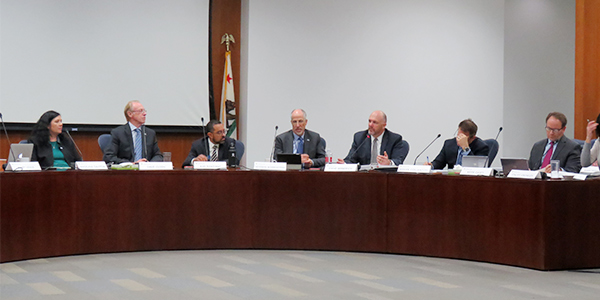By Hudson Sangree
FOLSOM, Calif. — CAISO is moving ahead expeditiously with a plan to stem systemwide market power, even though not everyone is convinced the effort is necessary or needs to move so quickly.
The project stems from analysis by CAISO staff and the ISO’s Department of Market Monitoring earlier this year that detected a limited number of hours when the potential for the exercise of systemwide market power existed.
The report led to a sometimes tense meeting in August of the ISO’s Market Surveillance Committee, in which participants voiced opposing views on the need for market power mitigation measures and the speed at which the process was moving. (See CAISO Stakeholders Split on Market Power Efforts.)
On Wednesday, Brad Cooper, CAISO’s senior manager of market design policy, briefed the Board of Governors on the ISO’s decision to kick off a stakeholder initiative to design a mitigation program. Staff issued a conceptual proposal in September and last month released a scoping document setting out the guiding principles for the effort.
Cooper said it has proven tricky to design a process that limits market power without unintended negative consequences. Of particular concern, he said, is being careful not to deter electricity imports from other states by controlling prices too much. Those imports will be necessary for meeting California’s needs going forward, he said.
“We want to make sure we don’t cut off our nose to spite our face, so to speak,” Cooper said.
The predicted potential for noncompetitive conditions occurs at the ISO’s balancing area level, not the local level, he said. It can involve hours when supply is constrained by transmission bottlenecks or a lack of resources, he said.
Though the problem isn’t immediate, CAISO leaders and staff members are concerned that system market power could become more of a factor in the next few years. Starting in 2021, the retirement of fossil fuel plants and the inability of solar power to meet evening peak demand will create a much tighter energy market than today, according to CAISO projections.
Stakeholders, however, remain divided on the need for mitigation efforts, Cooper told the board. Electricity suppliers have argued there’s no real evidence of the exercise of systemwide market power — only the potential for it to happen.
“PacifiCorp agrees with other stakeholders that nothing in the CAISO’s system market power analysis indicates an urgent need for the CAISO to conduct a policy initiative to design and implement new price mitigation procedures to address system-level market power,” the utility, a major exporter of energy into California, wrote in comments filed with the ISO.
The state’s investor-owned utilities and the California Public Utilities Commission have contended the effort is critically important, he said.
“System market power mitigation is vital to ensure competitive outcomes in a market that has become structurally uncompetitive at the system level in a higher number of hour and intervals. When the market is structurally uncompetitive, market power can be exercised, and uncompetitive bidding practices can successfully drive up the price,” Pacific Gas and Electric said in comments.
Staff plan to issue a straw proposal next month and bring a final plan to the board early next year so that it can be implemented by the spring of 2021 — before the anticipated shortfalls of summer that year. The designers are looking at a phased-in approach that will first address issues in the real-time market and then move to the day-ahead market in phase two, Cooper said.
Some commenters Wednesday took issue with the two-phased approach.
Raisa Ledesma Rodriguez, with the CPUC’s Energy Division, said the phased-in effort may be insufficient to head off the exercise of market power. A representative from PG&E said the day-ahead market is where the greatest potential for problems occurs.
CAISO CEO Stephen Berberich told the board that applying market power mitigation measures in the day-ahead market is more complex than in the real-time market. Staff are moving ahead on the project with a sense of urgency, he said.
“Our analysis doesn’t show a burning bridge at this point,” but it’s important get ahead of the issue, Berberich said.





